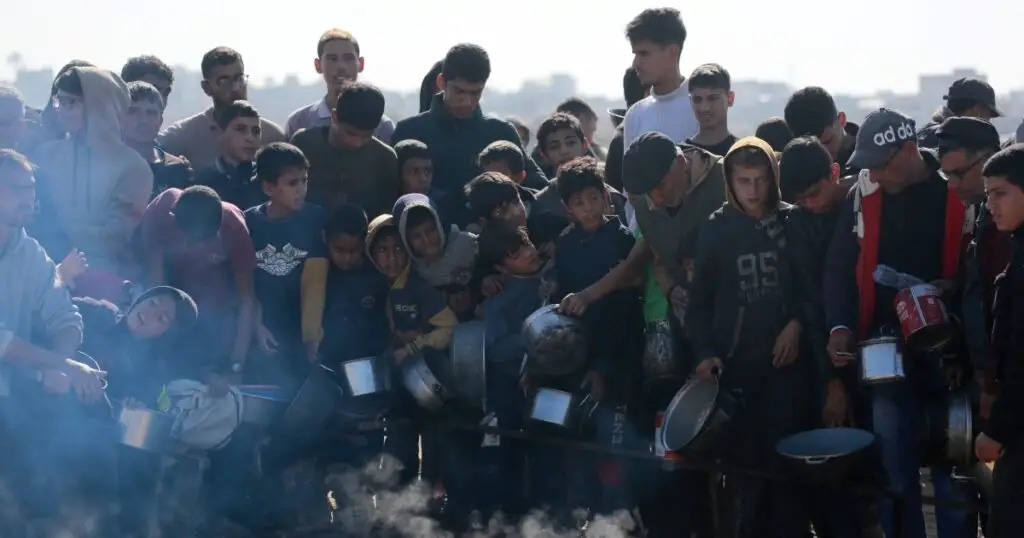Winter has now arrived in the northern hemisphere and has created a festive atmosphere in many places. In Gaza it has brought even more misery. The cold weather and rain have made life even more unbearable for the 1.9 million displaced Palestinians in Gaza.
It has rained heavily several times. Each time, the displaced people’s tents were flooded, damaged or destroyed, and what little some had was taken away by the floods.
This has resulted in many destitute families becoming even more in need. A new tent in Gaza can currently cost up to $1,000. A makeshift shelter – with the necessary wood and plastic to cover it – costs hundreds of dollars. A new blanket can cost up to $100. Nobody in the camps has such sums.
Many of those displaced had fled the bombs with only the clothes on their backs. Some tried to salvage clothing from the rubble, but few succeeded.
As winter approached, clothing prices skyrocketed. A pair of lightweight pajamas is now $95; a coat – up to $100. A pair of shoes – a rare commodity – can cost up to $75. Second-hand clothing markets have sprung up across the Gaza Strip to meet overwhelming demand, but even there prices are too high.
That’s why the camps are full of people shivering from the cold in thin summer clothing. Children run around barefoot in mud and puddles.
Fuel for heating that is either unavailable or unaffordable for most families. The cost of 8kg of petrol is $72. Wood is a little cheaper, but too expensive for most people.
The lack of clothing and fuel for heating in winter increases the risk of colds, flu and other illnesses that can be life-threatening in Gaza. A malnourished, vulnerable body, exhausted by fear and trauma, struggles with even a simple cold.
Hospitals in the Gaza Strip are barely functioning and mainly care for people seriously injured in the bombing. Due to a lack of materials and personnel, they can no longer treat simple diseases.
Diseases also spread because hygiene can no longer be maintained. The displaced people live in tents and have no access to warm water. They cannot shower or sometimes wash their hands. A bar of soap now costs $5, while a bottle of shampoo can cost up to $23.
But perhaps the most unbearable fact in Gaza today is the famine. The amount of humanitarian aid entering Gaza has decreased significantly since October, and we have felt the devastating impact throughout Gaza. There is famine not only in the north. All of Gaza is.
The price for what little food is available is incredible. A single bag of flour now costs more than $300. Other foods have also become more expensive. A kilo of lentils or a kilo of rice costs $7. Vegetables are hard to find and very expensive; 1kg of tomatoes costs $14; A single onion costs $2. Red meat and chicken are not to be found at all. We haven’t seen any in months.
The bakeries that were once a lifeline for families are closed because they cannot be supplied. Bread, the simplest and most basic food, has become a luxury that few of us can afford. Even when a family can obtain flour, it is often infested with bugs and tastes stale.
People are now forced to rely on “takaya” – charity soup kitchens – that provide small portions of food barely enough for a family. These organizations open at 11:00 a.m., resulting in large lines forming outside their distribution centers. Most families who manage to get a meal from them have nothing else to feed their children.
Hunger is not just limited to the physical pain that starving people suffer. It also has unbearable psychological effects. Parents have to watch their children cry for food during the long, cold nights. Some parents also had to watch their children starve to death. This psychological torment cannot be compared to anything else.
As I write these words I am starving, having not eaten anything since morning. When I look around I see children and adults, pale and thin, exhausted from hunger and cold. I wonder how much more they can take; How much more can each of us take?
The cruelest part of this suffering is the silence of the world, which watches from a distance but does not act. As the cold takes its toll and hunger makes it worse, we feel isolated and abandoned, as if we are cut off from the rest of humanity. And as much of the world prepares for the holidays, we prepare for loneliness, despair, and death.
The views expressed in this article are the author’s own and do not necessarily reflect the editorial stance of Al Jazeera.





